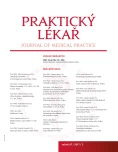Zdravotní stav zaměstnanců v automobilovém průmyslu
– pilotní studie
Authors:
J. Jarolímek 1,2; V. Žídková 3,4; P. Urban 5,6
Authors‘ workplace:
Hygienická stanice hlavního města Prahy se sídlem v Praze, Ředitel: RNDr. Jan Jarolímek, MBA
1; Přírodovědecká fakulta Univerzity Karlovy, Praha
Katedra sociální geografie a regionálního rozvoje
Vedoucí: prof. RNDr. Dagmar Dzúrová, CSc.
2; Lékař Baška, s. r. o., Baška
3; Lékařská fakulta Univerzity Palackého, Olomouc
Klinika pracovního lékařství
Přednostka: doc. MUDr. Marie Nakládalová, Ph. D.
4; Státní zdravotní ústav v Praze
Ředitelka: Ing. Jitka Sosnovcová
5; Klinika pracovního lékařství 1. LF UK a VFN, Praha
Přednostka: prof. MUDr. Daniela Pelclová, CSc.
6
Published in:
Prakt. Lék. 2017; 97(2): 56-60
Category:
Of different specialties
Overview
In Czechia, a general decreasing trend in the incidence of occupational diseases has been observed in the past decades. However, the automotive industry, where the incidence of occupational diseases is by contrast increasing, represents a striking exception. The unfavorable situation in the automotive industry is a challenge to be scientifically addressed. The aim of our pilot study was to compare some health indicators in workers at risk positions in the automotive industry and in workers performing non-hazardous work beyond this branch of economy. This is a cross-sectional epidemiological study based on data from a field survey questionnaire. The exposed group consisted of 90 employees of an automotive factory, a third-tier supplier according to its position in the global production networks. The workers performed risk work of category 2R (local muscular load). The control group was composed of 90 persons performing non-hazardous work beyond the automotive industry. Both groups came from the same geographical region and were comparable with respect to gender and BMI. The exposed group was slightly younger. Members of the control group experienced more frequently bad health in the last month, reported more consultation visits at their doctors, had higher incidence of musculoskeletal disorders, and have been more frequently taken in care by specialized physicians. Accordingly, we may infer that in our study the group of people employed in the automotive industry appeared to be healthier, despite of the fact that there are more regular smokers among them, they spend less time in the leisure outdoor activities, they have lower income and lower education level, which are factors usually associated with worse health. The observed findings may be partly influenced by the slight age difference between the two groups. The worse health of the control group may be related to the fact, that stress situations in work were reported almost twice as frequent in this group. However, we consider as most probable that the “healthy worker effect” has manifested itself in our study. This effect is a type of selection bias influencing the exposed group in such a way that it is eventually becoming healthier in comparison with the general population (selection of more healthy persons for work at hazardous positions, removal from work because of health problems etc.). To verify the hypotheses generated in our study, further research is needed, especially the cohort studies.
KEYWORDS:
occupational diseases – risk factors – incidence – healthy worker effect – automotive industry
Sources
1. Jarolímek J, Urban P, Pavlínek P, Dzúrová D. Occupational diseases in the automotive industry in Czechia – geographic and medical context. Int J Occup Med Environ Health, (2016); v tisku STÁLE???
2. Jarolímek J. Nemoci z povolání v automobilovém průmyslu ve Středočeském kraji. Prakt. Lék. 2013; 93(3): 100–104.
3. Jarolímek J, Urban P. Twenty year development of occupational diseases in the Czech Republic: Medical and geographical aspects. Cent Eur J Public Health 2014; 22(4): 251–256. 4. SZÚ. Systém monitorování zdravotního stavu obyvatelstva České republiky ve vztahu k životnímu prostředí. Souhrnná zpráva za rok 2015. Praha: Státní zdravotní ústav 2016.
5. MZ ČR. Nemocemi z povolání trpí nejvíce horníci. Tisková zpráva MZČR 2013 [online]. Dostupné z: http://www.mzcr.cz/dokumenty/nemocemi-z-povolani-trpi-nejvice-hornici-_8113_2778_1.html [cit. 2016-08-04].
6. Jedlička J, Kozelský T, Majchráková J. Analýza automobilového průmyslu. Praha: Česká spořitelna 2013 [online]. Dostupné z: http://www.csas.cz/static_internet/cs/Evropska_unie/Specialni_analyzy/Specialni_analyzy/Prilohy/euspa_analysis_of_the_automobile_industry.pdf [cit. 2014-12-03].
7. ČSÚ. Sčítání lidí, domů a bytů 2001. Počet obyvatel ekonomicky aktivních podle odvětví – výroba dopravních prostředků za okresy. Zdroj interní databáze ČSÚ 2011.
8. ČSÚ. Sčítání lidí, domů a bytů 2011. Počet obyvatel ekonomicky aktivních podle odvětví – výroba dopravních prostředků za okresy. Zdroj interní databáze ČSÚ 2011.
9. ACEA. EU economic report – Per Capita Production 2014 [online]. Dostupné z: http://www.acea.be/statistics/tag/category/per-capita-production [cit. 2015-02-17].
10. CzechInvest. Automotive Industry in the Czech Republic – Investment Opportunities (2015) [online]. Dostupné z: http://www.czechinvest.org/data/files/automotive-brochure-2015-97.pdf [cit. 2015-04-02].
11. Hendl J. Kvalitativní výzkum – základní metody a aplikace. Praha: Portál 2008.
12. Pergler P, Disman M, a kol. Vybrané techniky sociologického výzkumu. Praha: Nakladatelství svoboda 1969; 235–537.
13. Ženka J, Pavlínek P. The Czech automotive industry in global production networks: regional dimensions of upgrading between 1998 and 2008. Geografie 2013; 118(2): 166–137.
14. Monson RR. Observations on the Healthy Worker Effect. J Occup Med 1986; 28(6): 425–433.
15. Choi BCK. Definition, sources, magnitude, effect modifiers, and strategies of reduction of the Healthy Worker Effect. J Occup Med 1992; 34(10): 979–988.
Labels
General practitioner for children and adolescents General practitioner for adultsArticle was published in
General Practitioner

2017 Issue 2
- Metamizole at a Glance and in Practice – Effective Non-Opioid Analgesic for All Ages
- Hope Awakens with Early Diagnosis of Parkinson's Disease Based on Skin Odor
- Metamizole vs. Tramadol in Postoperative Analgesia
- Advances in the Treatment of Myasthenia Gravis on the Horizon
- Metamizole in perioperative treatment in children under 14 years – results of a questionnaire survey from practice
Most read in this issue
- Firearm license – a summary of changes in the assessment of medical fitness of applicants
- Reasons for hospitalization in patients diagnosed from the schizophrenia, schizotypal and delusional disorders
- The practical application of clinical criteria for the recognition of the disease of the lumbar spine from overloading as an occupational disease
- Optical coherence tomography application in diagnostics and monitoring of idiopathic intracranial hypertension patients
